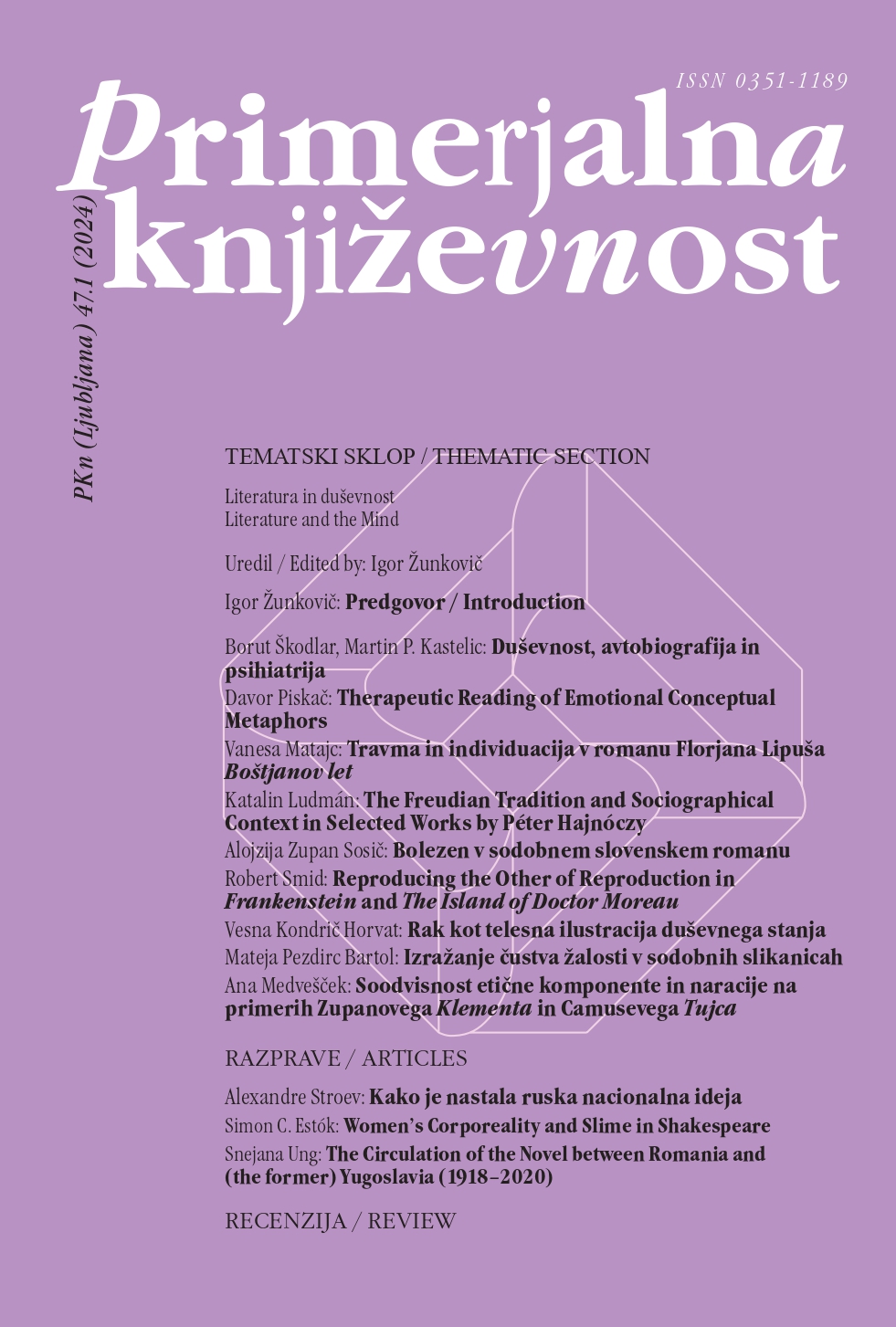Trauma and Individuation in Florjan Lipuš’s Novel The Flight of Boštjan
DOI:
https://doi.org/10.3986/pkn.v47.i1.03Keywords:
literature and psychoanalysis, Slovenian literature, Lipuš, Florjan: The Flight of Boštjan, Jung, Carl Gustav, archetypes, mythology, Damasio, Antonio, cognitive literary studiesAbstract
In 2003, Florjan Lipuš published the novel The Flight of Boštjan. The story of the novel revolves around an incisive event from the protagonist’s childhood during the Second World War in the Slovenian minority community in Austrian Carinthia: The gendarmerie in the service of the Nazi regime takes the protagonist’s mother from her home and she never returns. The event is presented as a traumatic experience that the child’s perception cannot integrate into consciousness as a memory accessible in a clear and complete account of the event. Only the horror and the child’s inability to understand the meaning of this event, which is fundamental for him, function as a repression within the “mechanism” of trauma. In Lipuš’s novel, the child’s experiences of horror and loss and the gradual healing of the trauma are presented, named and structured in an original and thematically particularly suggestive way: through variable repetitions, especially of a symbolic motif referring to a mythological being called “škopnik” in the Slovenian ethnological tradition (within the framework of Slavic mythology). This article tends to recognize the cognitive power of literature in the literary-narrative structures of the universally human basic experiences of existence. Reading the novel links it in particular to the psychoanalysis of C. G. Jung and his concept of archetypes.
References
Borovnik, Silvija. »Lipuševi deli Boštjanov let in Poizvedovanje za imenom kot sklepanje kroga s krepkejšo črto«. Jezik in slovstvo, let. 58, št. 4, 2013, str. 17–26.
Borovnik, Silvija. »Patologija slovenske vasi, nasilje verske institucije in arheologija besede v Lipuševi prozi«. Slavistična revija, let. 48, št. 2, 2000, str. 119–140.
Caruth, Cathy. »Recapturing the Past: Introduction«. Trauma: Explorations in Memory, ur. Cathy Caruth, Johns Hopkins University Press, 1995, str. 151–157.
Damasio, Antonio. Iskanje Spinoze: veselje, žalost in čuteči možgani. Založba Krtina, 2008.
Fludernik, Monika, ur. Beyond Cognitive Metaphor Theory. Routledge, 2011.
Franz, Marie-Luise von. Interpretacija bajki. Scarabelus-naklada, 2007.
Haderlap, Maja. Angel pozabe. Litera, 2012.
Jung, Carl Gustav. Aion: prispevki k simboliki sebstva. Celjska Mohorjeva družba, 2010.
Jung, Carl Gustav. Arhetipi in kolektivno nezavedno. Beletrina, 2023.
Jung, Carl Gustav. Razvoj osebnosti. Beletrina, 2021.
Jurić Pahor, Marija. Memorija vojne: soška fronta v spominski literaturi vojakov in civilistov. Mohorjeva, 2019.
Jurić Pahor, Marija. »Narativnost spominjanja: vpogledi v avto/biografsko usmerjeno raziskovanje in govorico ekstremne travme«. Avtobiografski diskurz, ur. Alenka Koron in Andrej Leben, ZRC SAZU, 2011, str. 161–173.
Lakoff, George. »Sodobna teorija metafore«. Kaj je metafora?, ur. Božidar Kante, Krtina, 1998, str. 271–325.
Leben, Andrej. »Koroške (slovenske) vojne pripovedi med reprezentacijo in diskurzom«. Primerjalna književnost, let. 38, št. 3, 2015, str. 121–138.
Leben, Andrej. V borbi smo bile enakopravne: uporniške ženske na Koroškem v letih 1939–1955. Založba Drava, 2003.
Lipuš, Florjan. Boštjanov let. Litera, 2003.
Lipuš, Florjan. Gramoz. Litera, 2017.
Lipuš, Florjan. Poizvedovanje za imenom. Litera, 2013.
Markič, Olga. »Nevrobiologija čustev in občutkov«. Antonio Damasio, Iskanje Spinoze, Krtina, 2008, str. 287–302.
Stanič, Katja. Zgodba v ogledalu: odsev teorije kolektivnega nezavednega C. G. Junga v slovenskem mitološkem izročilu. 2014. Filozofska fakulteta, Univerza v Ljubljani, diplomsko delo.
Šmitek, Zmago. Mitološko izročilo Slovencev. Študentska založba, 2004.
Troha, Nevenka. »Slovenci v Avstriji«. Slovenska novejša zgodovina, zv. 1, ur. Jasna Fischer idr., Mladinska knjiga / Inštitut za novejšo zgodovino, 2006, str. 552–564.


